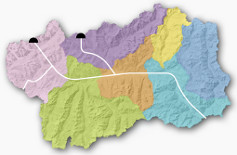Saint Bernard and the medieval hospices
The reception of pilgrims along the Via Francigena
A welcoming system developed in medieval times around the Great-Saint-Bernard pass. It included the hospice of Saint Nicholas and Saint Bernard at the Great-Saint-Bernard pass; the premises offering free lodging (the hospices in Fonteintes, Saint-Rhémy, Saint-Oyen and Etroubles); the paid hospices in the villages along the road; the so-called marronier, an Alpine guide service that provided emergency support to travellers in difficulty and that maintained roads; a market where travellers could purchase commodities.
Hospitals were founded also in Quart, Nus, Chambave, Châtillon, Saint-Vincent, Montjovet, Verres, Bard and Donnas, on the road from Aosta to Pont-Saint-Martin.
The first confirmation of the existence of a religious hospice structure at the summit of Mont-Joux (Great Saint Bernard pass) dates back to 1100, when Umberto II of Moriana-Savoia raised the original endowment of the “ecclesia Sancti Nicholai Montis Iovis”. Therefore, on this date the church dedicated to Saint Nicholas already existed; unfortunately the sources don't allow us to establish the precise date of its foundation, nor its specific use as a hospice.
The first clear reference to a hospice building can be found in a diary written on a pilgrimage from Rome to Jerusalem owned by the Icelandic abbot Nikulas of Munkathvera, who in his journey from Thingor to Rome (around 1154) used the Great-SAint-Bernard pass and noted the presence at the pass of a “Bjanardz spitali”.
The foundation of the hospice near the Great Saint Bernard pass, dated around the mid XI century, is attributed to Saint Bernard, archdeacon of the Cathedral of Aosta. Saint Bernard died around 1080 and was presumably born in the Aosta Valley, not in Menthon, as legend has it.
The hospitality network between the Little-Saint-Bernard and Aosta
A similar welcoming system was set up along the road leading from the Little-Saint-Bernard Alpine pass to the city of Aosta. There were hospices at the Little-Saint-Bernard pass and domus hospitales in La Balme (Pré-Saint-Didier), in Morgex (location of an important annual fair and of a weekly market) and in La Salle.
Moving onwards to Aosta, hospices were founded in Leverogne, near Arvier (the external walls of this domus still have decorations from the XV century representing "The Parade of Sins and the Works of Mercy"), in Villeneuve and in Sarre.
The foundation of the Little-Saint-Bernard hospital is attributed to the same Saint Bernard. Its foundation date is unknown; the hospice was mentioned for the first time in a papal document in 1145 (the Papal Bull by Pope Eugenius III). Less than 60 years after Saint Bernard's death the hospital had already his name, which seems to confirm that he was the founder of this hospice too.













